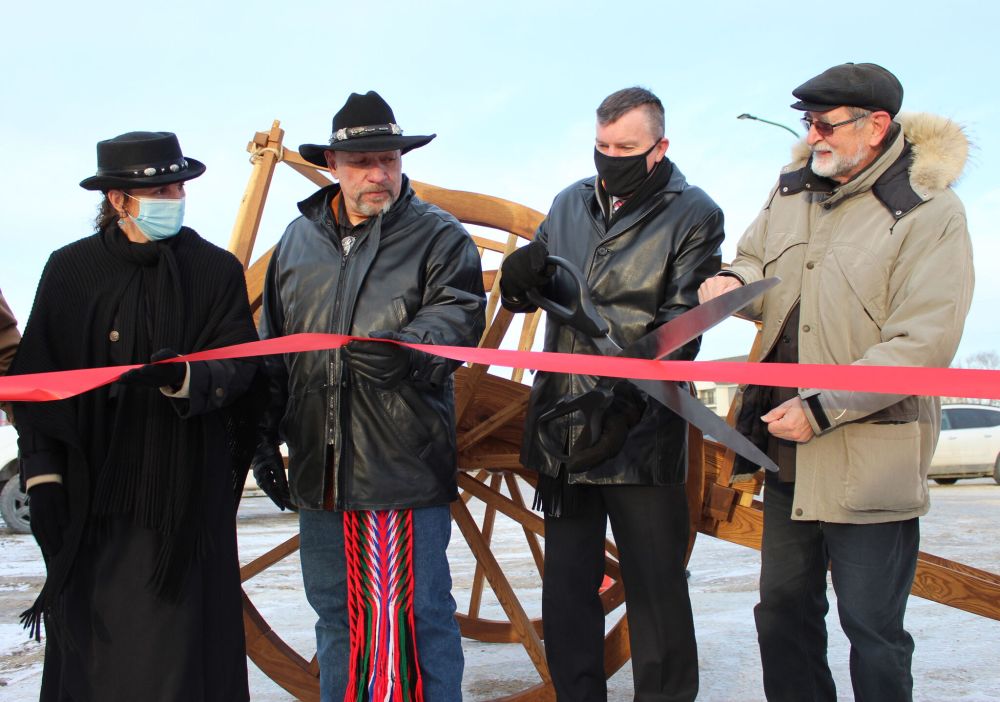Metis cart rolls into Niverville
Advertisement
Hey there, time traveller!
This article was published 15/12/2021 (1226 days ago), so information in it may no longer be current.
A Red River cart unveiled in Niverville is intended to serve as a permanent reminder of the bonds forged nearly 150 years ago between local Metis and the first Mennonite settlers.
Organizers and dignitaries gathered Saturday at the town’s new Community Resource and Recreation Centre (CRRC) for an indoor program and outdoor ribbon-cutting ceremony.
The public had a chance to see the 800-pound cart up close before it was placed into storage for the winter to await the construction of a timberframe shelter that will protect it from the elements.

The cart—handmade near Oakbank by Jerome Cartworks, Canada’s only producer of historically accurate, fully operational Red River carts—will stand at the entrance to the multiplex parking lot.
It symbolizes the vital assistance provided by local Metis to the Mennonite settlers who began arriving at the confluence of the Rat and Red rivers in 1874.
“In the first couple of years, they were absolutely lifesavers,” said Ernest Braun, a retired schoolteacher and amateur Mennonite historian who broached the idea of bringing a Red River cart to Niverville more than a year ago.
Braun is a member of an informal committee that internally raised most of the $5,000 needed to purchase the cart. Private donations were also accepted. The Town of Niverville is covering the cost of the wooden shelter and concrete pad.
Representatives from the Crow Wing Trail Association, RM of Ritchot, and Mennonite Heritage Village were present for the unveiling, along with cart builders Armand and Kelly Jerome, who revealed they will soon retire their business after completing more than two dozen carts over 20 years.
Each one involves 200 hours of labour. The Niverville cart is constructed of oak, ash, and elm, three hardwoods that grow locally.
The two-wheeled carts were pulled by oxen, mules, or horses. Armand Jerome said the earliest records of the carts date back to 1801. Built without nails, they could carry loads of 1,000 pounds and were used throughout much of the 19th century.
Mayor Myron Dyck recounted how the Red River Metis built the immigration sheds south of town that housed the first Mennonites, and carted settlers and supplies from the landing site. They also provided food, navigational guidance, and natural remedies.
Braun, who donned traditional Mennonite attire for the special occasion, said he was born on land granted to the Metis by the 1870 Manitoba Act.
Raised with a general awareness of the connection between the Metis and the Mennonites, Braun said his knowledge and appreciation were deepened while compiling the Historical Atlas of the East Reserve with co-editor Glen Klassen.
“As you do the map, you realize, there are logistical issues here that I never paid any attention to,” Braun said.
“How did we get from the Rat River to the sheds? And who built the sheds? It came into much sharper focus, exactly how critical all this was.”
Dyck said the cart will prompt Niverville residents to stop and think about the town’s formation.
“It’s an opportunity for our children and our children’s children to have things to ask questions about, and say, ‘How did this happen?’ and ‘Why did this happen?’ and ‘Who are we?’”
Answers to those questions can be had on the second floor of the multiplex, which houses a historical exhibit. The heritage wall along Main Street provides another tie-in.
Braun said he was thankful the cart project came together after a bumpy start. This past spring, the Jeromes were swamped with backorders and initially said no, before pulling out all the stops to deliver a cart by Christmas.
“This kind of cart making is a lost art,” Braun said. “This will be a priceless contribution to the material culture of Manitoba and of the Manitoba Metis.”
Armand Jerome began making Red River carts using tools and know-how he inherited from his father, a furniture maker. Over the years, Jerome improved the design of the carts to better handle wear and tear.
With retirement approaching, he is now compiling his knowledge into a manual for future cart builders, even as he confessed uncertainty about the future of the trade.
“The work is hard, the wood is expensive.”
Jerome said he was honoured to work with the Niverville committee to create a piece of “living history” that will be “a lasting monument” to Metis contributions to Niverville.
Braun said Niverville wouldn’t be what it is today without the support of the Metis.
“We need to give credit to where credit is due.”
Braun said he hopes the Jeromes will return to Niverville in 2024 to celebrate the 150th anniversary of the Mennonite landing.
